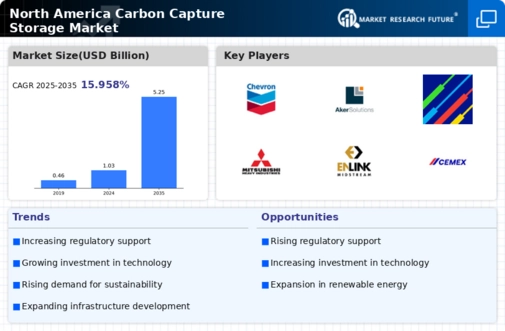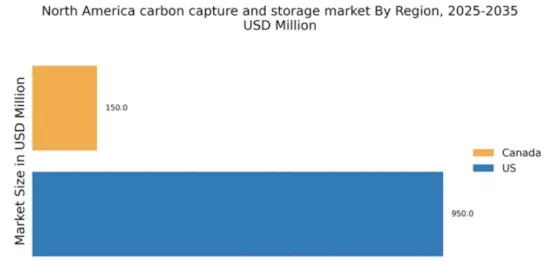Increasing Regulatory Support
The carbon capture-storage market in North America is experiencing a surge in regulatory support, which appears to be a crucial driver for its growth. Governments at both federal and state levels are implementing policies that incentivize carbon capture technologies. For instance, the 45Q tax credit allows for a tax benefit of up to $50 per ton of CO2 captured and stored, significantly enhancing the economic viability of projects. This regulatory framework not only encourages investment but also fosters innovation within the industry. As a result, companies are more likely to engage in carbon capture initiatives, thereby expanding the market. Furthermore, the alignment of state-level regulations with federal goals indicates a cohesive approach to climate change mitigation, which could lead to a more robust carbon capture-storage market in the region.
Growing Public Awareness and Support
Growing public awareness and support for climate action is increasingly influencing the carbon capture-storage market in North America. As citizens become more informed about the impacts of climate change, there is a rising demand for effective solutions, including carbon capture technologies. Public sentiment appears to favor initiatives that demonstrate a commitment to reducing greenhouse gas emissions. This shift in public opinion is prompting policymakers to prioritize carbon capture projects, leading to increased funding and support. Moreover, community engagement in carbon capture initiatives can enhance project acceptance, which is vital for the successful implementation of carbon capture-storage solutions. As public awareness continues to grow, it is likely that the market will experience further expansion.
Rising Corporate Sustainability Goals
In recent years, corporations across North America have increasingly adopted sustainability goals, which seem to be driving the carbon capture-storage market. Many companies are committing to net-zero emissions targets, prompting them to explore carbon capture technologies as a viable solution. This trend is particularly evident in industries such as oil and gas, where firms are investing heavily in carbon capture projects to meet their environmental commitments. According to industry reports, investments in carbon capture technologies are projected to reach $2 billion annually by 2027. This corporate shift towards sustainability not only enhances the demand for carbon capture solutions but also encourages collaboration between businesses and technology providers, thereby fostering growth within the carbon capture-storage market.
Investment in Infrastructure Development
Investment in infrastructure development is emerging as a significant driver for the carbon capture-storage market in North America. The establishment of pipelines and storage facilities is essential for the effective transportation and sequestration of captured CO2. Recent government initiatives have allocated substantial funding for infrastructure projects aimed at supporting carbon capture technologies. For example, the U.S. Department of Energy has announced funding of $1.5 billion for carbon capture and storage projects, which is expected to enhance the market's infrastructure capabilities. This investment not only facilitates the deployment of carbon capture technologies but also creates job opportunities, thereby contributing to economic growth in the region.
Technological Advancements in Capture Methods
Technological advancements in carbon capture methods are playing a pivotal role in shaping the carbon capture-storage market in North America. Innovations such as direct air capture and improved solvent technologies are enhancing the efficiency and cost-effectiveness of carbon capture processes. For instance, recent developments have reduced the energy requirements for capturing CO2, which could lower operational costs by up to 30%. These advancements not only make carbon capture more accessible but also attract investment from various sectors. As technology continues to evolve, it is likely that the carbon capture-storage market will expand, driven by the need for more efficient and scalable solutions to combat climate change.


















Leave a Comment